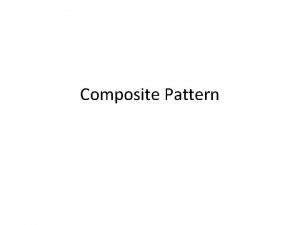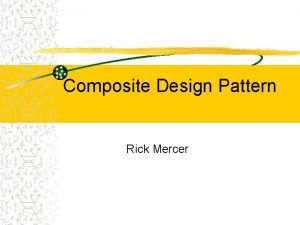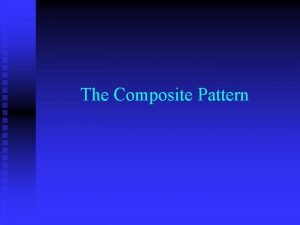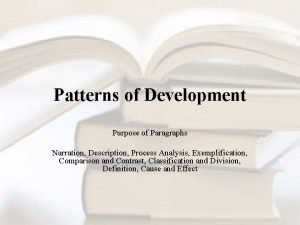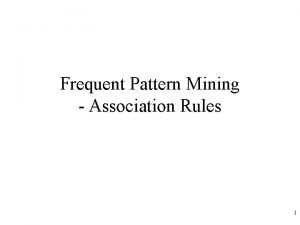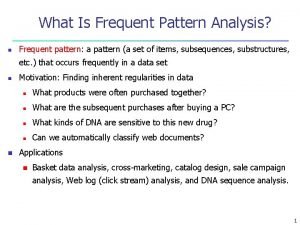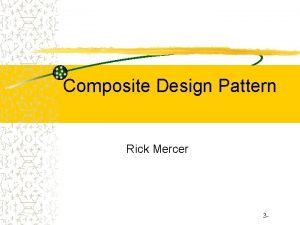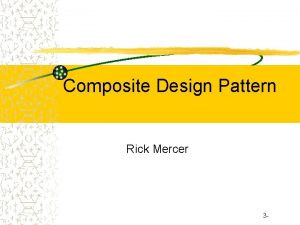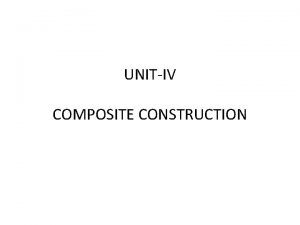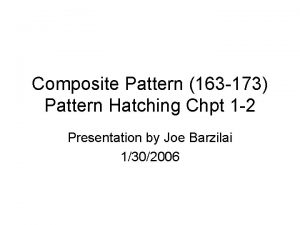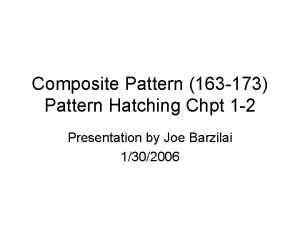Composite Pattern Composite pattern is used where we














- Slides: 14

Composite Pattern

• Composite pattern is used where we need to treat a group of objects in similar way as a single object. Composite pattern composes objects in term of a tree structure to represent part as well as whole hierarchies. • This type of design pattern comes under structural pattern as this pattern creates a tree structure of group of objects. • This pattern creates a class contains group of its own objects. This class provides ways to modify its group of same objects. • We are demonstrating use of Composite pattern via following example in which show employees hierarchy of an organization.


• Intent Compose objects into tree structures to represent part-whole hierarchies. • Motivation Graphics applications like drawing editors and schematic capture systems let users build complex diagrams out of simple components. The user can group components to form larger components, which in turn can be grouped to form still larger components. A simplementation could define classes for graphical primitives such as Text and Lines plus other classes that act as containers for these primitives. But there's a problem with this approach: Code that uses these classes must treat primitive and container objects differently, even if most of the time the user treats them identically. Having to distinguish these objects makes the application more complex.

• Applicability Use the Composite pattern when • you want to represent part-whole hierarchies of objects. • you want clients to be able to ignore the difference between compositions of objects and individual objects. Clients will treat all objects in the composite structure uniformly.

• Participants • Component (Graphic) • Leaf (Rectangle, Line, Text, etc. ) • Composite (Picture) • Client.

• Collaborations • Clients use the Component class interface to interact with objects in the composite structure. If the recipient is a Leaf, then the request is handled directly. If the recipient is a Composite, then it usually forwards requests to its child components, possibly performing additional operations before and/or after forwarding.

• Consequences • • The Composite pattern defines class hierarchies consisting of primitive objects and composite objects. makes the client simple. makes it easier to add new kinds of components. can make your design overly general.

Implementation • We have a class Employee which acts as composite pattern. Composite. Pattern. Demo, our demo class, will use Employee class to add department level hierarchy and print all employees.





 Moment of inertia composite shapes
Moment of inertia composite shapes Composite pattern making
Composite pattern making Composite pattern c
Composite pattern c Composite pattern making
Composite pattern making In a premix burner used in fes the fuel used is
In a premix burner used in fes the fuel used is In a premix burner used in fes the fuel used is
In a premix burner used in fes the fuel used is Used in transferring marks
Used in transferring marks Radial line development method is used for development of
Radial line development method is used for development of Patterns of development description examples
Patterns of development description examples Pattern of development
Pattern of development Minutiae
Minutiae Pattern and pattern classes in image processing
Pattern and pattern classes in image processing Association pattern mining
Association pattern mining Frequent pattern
Frequent pattern Composite foods examples
Composite foods examples

